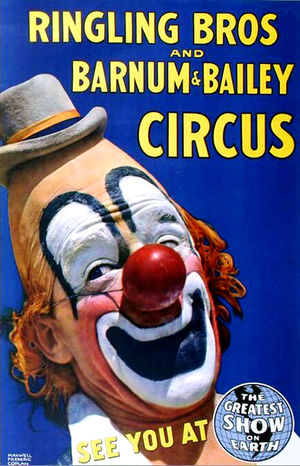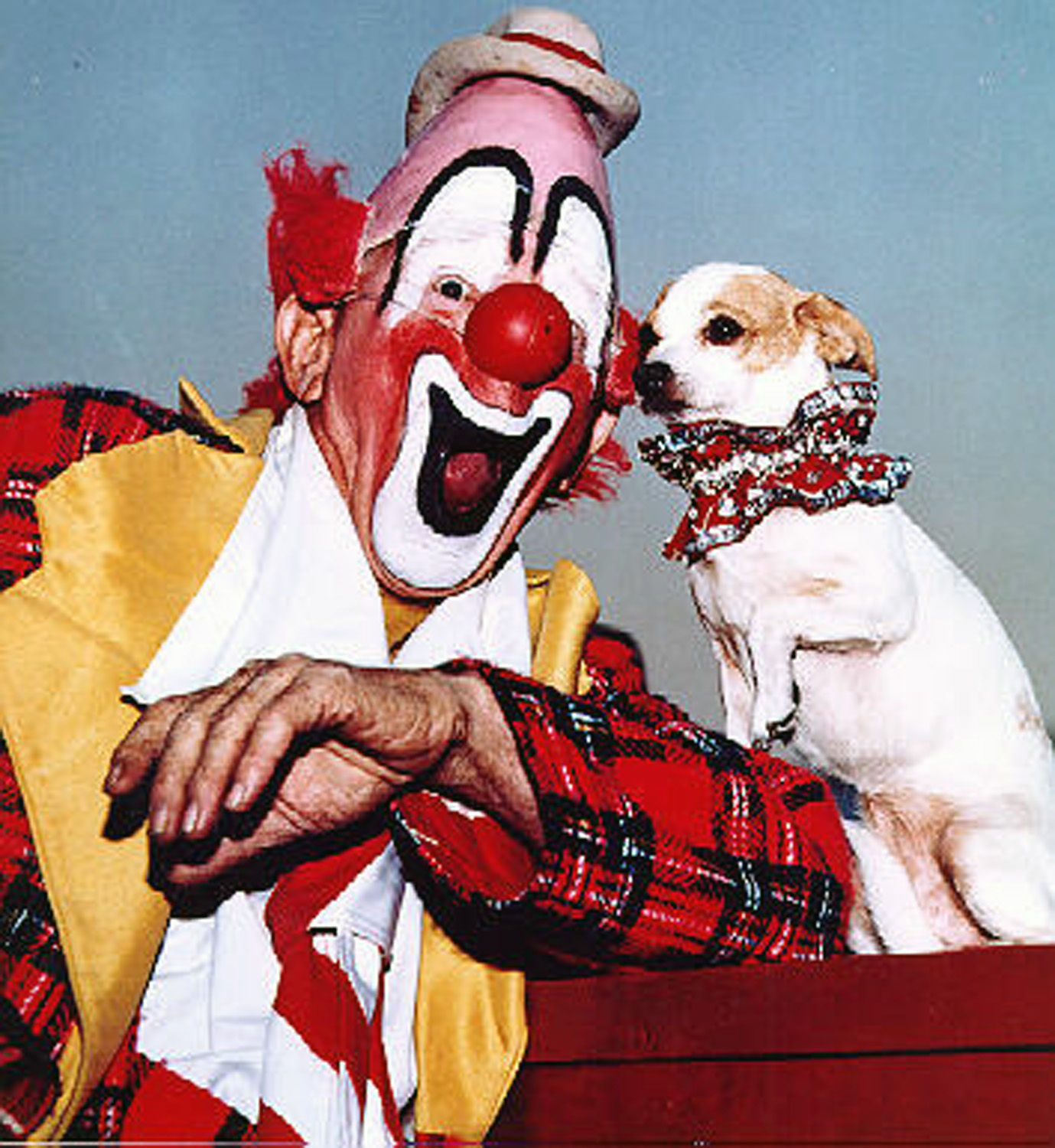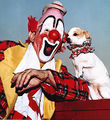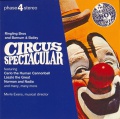Difference between revisions of "Lou Jacobs"
From Circopedia
(→Image Gallery) |
(→Image Gallery) |
||
| (46 intermediate revisions by the same user not shown) | |||
| Line 1: | Line 1: | ||
| + | [[File:Lou_Jacobs_poster.jpg|300px|right]] | ||
==Clown== | ==Clown== | ||
| Line 4: | Line 5: | ||
| − | + | One of the most recognizable clowns in recent circus history, Lou Jacobs's career spanned 62 years, 60 of which he spent with [[Ringling Bros. and Barnum & Bailey]]. Jacobs (1902-1992) was born Johann Ludwig Jacob in 1903 in Bremerhaven, the seaport of the city of Bremen, Germany, where his father worked in a shipyard. Until the outbreak of WWII, Germany was the epicenter of Europe's circus and variety shows, and Jacobs's parents created a song-and-dance act which they performed in local "varieté" theaters. | |
At school, young Ludwig demonstrated great skill in gymnastics. Moreover, he had a taste for show business. Following WWI, his father began to train him in basic acrobatics, barrel-jumping (a specialty rarely seen today, but quite popular then, especially in Germany and Russia), and—since Ludwig had a natural ability for it—contortion. By then, Jacobs had already made his debut in show business: in 1910, at age seven, he appeared on stage as the rear end of an alligator, a costume whose front end was animated by his elder brother, Karl. | At school, young Ludwig demonstrated great skill in gymnastics. Moreover, he had a taste for show business. Following WWI, his father began to train him in basic acrobatics, barrel-jumping (a specialty rarely seen today, but quite popular then, especially in Germany and Russia), and—since Ludwig had a natural ability for it—contortion. By then, Jacobs had already made his debut in show business: in 1910, at age seven, he appeared on stage as the rear end of an alligator, a costume whose front end was animated by his elder brother, Karl. | ||
| − | The economic situation in Germany was abysmal after the first World War. In 1923, Jacobs followed his brother to the United States. There, he found employment as an acrobat, working with a father-and-son comedy acrobatic act in which he played the straight man. Then, in late 1924, he teamed up in another comedy act with a contortionist named Davis, who had signed a contract with Ringling Bros. and Barnum & Bailey for the 1925 season. | + | ===Lou in America=== |
| + | |||
| + | The economic situation in Germany was abysmal after the first World War. In 1923, Jacobs followed his brother to the United States. There, he found employment as an acrobat, working with a father-and-son comedy acrobatic act in which he played the straight man. Then, in late 1924, he teamed up in another comedy act with a contortionist named Davis, who had signed a contract with Ringling Bros. and Barnum & Bailey Circus for the 1925 season. | ||
Jacobs, who had by then Anglicized his name to Lou, made his debut with ''The Greatest Show On Earth'' in 1925. There he discovered that his vocation was clowning. In 1926, he became one of the dozens of clowns appearing in the show. Jacobs found himself in good company: among the other clowns was [[Felix Adler]]. (Later, Jacobs would be joined in the show by another great German-born clown, [[Otto Griebling]], and by [[Emmett Kelly]].) | Jacobs, who had by then Anglicized his name to Lou, made his debut with ''The Greatest Show On Earth'' in 1925. There he discovered that his vocation was clowning. In 1926, he became one of the dozens of clowns appearing in the show. Jacobs found himself in good company: among the other clowns was [[Felix Adler]]. (Later, Jacobs would be joined in the show by another great German-born clown, [[Otto Griebling]], and by [[Emmett Kelly]].) | ||
| − | Jacobs's makeup was inspired by Albert Fratellini, one of the celebrated Fratellinis. A trio of extremely talented clowns, the | + | Jacobs's makeup was inspired by Albert Fratellini, one of the celebrated [[Les Fratellini|Fratellinis]]. A trio of extremely talented clowns, the Fratellinis were among Europe's greatest circus stars. Originally, Jacobs applied his makeup on a white base (which explains why, in many circus writings, he is often referred to as a "whiteface" clown). In later years, however, his makeup became closer to the Fratellini original, with a flesh-colored base. His distinctive and efficient makeup, along with Jacobs's oversized and colorful costume (which he wore over his 6'11" frame) made him easily recognizable in the vast expanses of the Ringling's giant big top (and later, in sport arenas). |
| + | |||
| + | Jacobs's clown face eventually became an iconic image for Ringling Bros. and Barnum & Bailey's advertising; in 1966, it even appeared on a U.S. postage stamp celebrating the circus. | ||
| − | + | ===A Master Clown=== | |
| − | Unlike many of his fellow clowns, Jacobs's created his own gags, for which he had an unbridled imagination. He can be seen in Cecil B. DeMille's film ''The Greatest Show On Earth'' (1952), parading on the hippodrome track in his famous self-propelled bathtub. For the same movie, Jacobs helped Jimmy Stewart develop his character of Buttons the Clown. Jacobs's two best-remembered routines were a hunting scene in which his chihuahua, Knucklehead (later replaced by PeeWee), played a mischievous rabbit, and the 2x3-foot midget car into which the former contortionist squeezed all of his 6'1" body. | + | [[File:Lou_Jacobs_and_Knucklehead.jpg|thumb|left|300px|Lou_Jacobs_and_Knucklehead (c.1955)]]Unlike many of his fellow clowns, Jacobs's created his own gags, for which he had an unbridled imagination. He can be seen in Cecil B. DeMille's film ''The Greatest Show On Earth'' (1952), parading on the hippodrome track in his famous self-propelled bathtub. For the same movie, Jacobs helped Jimmy Stewart develop his character of Buttons the Clown. Jacobs's two best-remembered routines were a hunting scene in which his chihuahua, Knucklehead (later replaced by PeeWee), played a mischievous rabbit, and the 2x3-foot midget car into which the former contortionist squeezed all of his 6'1" body. |
Jacobs married Jean Rockwell, a former Ringling showgirl, in 1953. They had two daughters: [[Lou Ann Jacobs|Lou Ann]], who became an aerialist and an elephant trainer, and [[Dolly Jacobs|Dolly Jean]], an aerialist who became one of America's greatest circus stars, eventually creating [[Circus Sarasota]] with her husband, [[Pedro Reis]]. | Jacobs married Jean Rockwell, a former Ringling showgirl, in 1953. They had two daughters: [[Lou Ann Jacobs|Lou Ann]], who became an aerialist and an elephant trainer, and [[Dolly Jacobs|Dolly Jean]], an aerialist who became one of America's greatest circus stars, eventually creating [[Circus Sarasota]] with her husband, [[Pedro Reis]]. | ||
| − | At the end of the 1985 season, Jacobs retired from performing. He was then 82 years old, and his health was beginning to fail. He remained active, however. He had been a Master Teacher at Ringling Bros. and Barnum & Bailey [[Clown College]] since its inception in 1968, | + | At the end of the 1985 season, Jacobs retired from performing. He was then 82 years old, and his health was beginning to fail. He remained active, however. He had been a Master Teacher at Ringling Bros. and Barnum & Bailey [[Clown College]] since its inception in 1968, and he held the position until 1991. He was, by all accounts, the College's most revered faculty member for all of the twenty-three years he taught there. |
| − | In 1987, [[Kenneth Feld]] presented Jacobs with a Lifetime Achievement Award on behalf of Ringling Bros. and Barnum & Bailey. The following year, Jacobs saw his star on Sarasota's [[Circus Ring of Fame]] unveiled. In 1989, he was inducted into both the [[Circus Hall of Fame]] in Peru, Indiana, and the newly formed [[Clown Hall of Fame]] in Delavan, Wisconsin. | + | In 1987, [[Kenneth Feld]] presented Jacobs with a Lifetime Achievement Award on behalf of Ringling Bros. and Barnum & Bailey Circus. The following year, Jacobs saw his star on Sarasota's [[Circus Ring of Fame]] on St. Armands Circle unveiled. In 1989, he was inducted into both the [[Circus Hall of Fame]] in Peru, Indiana, and the newly formed [[Clown Hall of Fame]] in Delavan, Wisconsin. |
| − | Lou Jacobs died of heart failure on September 13, 1992, in his hometown of Sarasota, Florida. He was 89 years old. | + | Lou Jacobs died of heart failure on September 13, 1992, in his hometown of Sarasota, Florida. He was 89 years old. In 2013, his native city of Bremerhaven, in Germany, recognized him on its website with a [http://www.bremerhaven.de/meer-erleben/stadtleben/hall-of-fame/lou-jacobs-von-geestemuende-aus-in-die-groesste-show-der-erde.78841.html special tribute]. |
==Image Gallery== | ==Image Gallery== | ||
| Line 32: | Line 37: | ||
Image:Lou_Jacobs_and_elephant.jpg|Lou Jacobs on a promotional postcard (c.1950) | Image:Lou_Jacobs_and_elephant.jpg|Lou Jacobs on a promotional postcard (c.1950) | ||
Image:Lou_Jacobs_RBBB_postcard.jpg|Lou Jacobs on a promotional postcard (c.1950) | Image:Lou_Jacobs_RBBB_postcard.jpg|Lou Jacobs on a promotional postcard (c.1950) | ||
| + | File:Lou_Jacobs_on_lot.jpeg|Lou Jacobs (c.1950) | ||
| + | Image:Lou_Jacobs_and_Emmett_Kelly_(c.1950).jpg|Lou Jacobs and Emmett Kelly on a promotional postcard (c.1950) | ||
Image:Lou Jacobs 1951.jpg|Lou Jacobs (1951) | Image:Lou Jacobs 1951.jpg|Lou Jacobs (1951) | ||
| − | + | File:Lou_Jacobs_(1951).jpg|Lou Jacobs (1951) | |
| + | File:Lou_Jacobs_and_Knucklehead.jpg|Lou Jacobs & Knucklehead (c.1955) | ||
| + | File:Ringling_Program_Mexico_(1958).jpg|Ringling Program Cover featuring Lou Jacobs (1958) | ||
| + | File:Lou_Jacobs_Paris_Ringling_Ad.jpeg|Ringling Advertisement in Paris (1963) | ||
| + | File:Lou_Jacobs_poster.jpg|Poster featuring Lou Jacobs (c.1965) | ||
| + | File:Lou_Jacobs_Stamp.jpg|Lou Jacobs U.S. Postage Stamp (1966) | ||
| + | File:Lou_Jacobs-Charlie_Bell-Earl_Shipley_(1964).jpg|Lou Jacobs (left), Charlie Bell and Earl Shipley (1964) | ||
Image:Lou_Jacobs_disc_cover.jpg|Lou Jacobs, Ringling Disc Cover (c.1970) | Image:Lou_Jacobs_disc_cover.jpg|Lou Jacobs, Ringling Disc Cover (c.1970) | ||
| + | File:Lou_Jacobs_and_family.jpg|Lou Jacobs and his family (c.1970) | ||
| + | File:Lou_Jacobs_and_Michu_(1974).jpeg|Lou Jacobs and Michu (1974) | ||
| + | File:Lou_Jacobs_and_Michu_2_(1974).jpeg|Lou Jacobs and Michu (1974) | ||
| + | File:Lou_Jacobs,_Dolly,_Feld.jpeg|Dolly, Lou, Irvin Feld (c.1980) | ||
| + | Image:Jacobs_family.jpg|Lou, Dolly, and Jean Jacobs (c.1980) | ||
</gallery> | </gallery> | ||
Latest revision as of 18:48, 1 August 2019
Clown
By Dominique Jando
One of the most recognizable clowns in recent circus history, Lou Jacobs's career spanned 62 years, 60 of which he spent with Ringling Bros. and Barnum & Bailey. Jacobs (1902-1992) was born Johann Ludwig Jacob in 1903 in Bremerhaven, the seaport of the city of Bremen, Germany, where his father worked in a shipyard. Until the outbreak of WWII, Germany was the epicenter of Europe's circus and variety shows, and Jacobs's parents created a song-and-dance act which they performed in local "varieté(German, from the French: ''variété'') A German variety show whose acts are mostly circus acts, performed in a cabaret atmosphere. Very popular in Germany before WWII, Varieté shows have experienced a renaissance since the 1980s." theaters.
At school, young Ludwig demonstrated great skill in gymnastics. Moreover, he had a taste for show business. Following WWI, his father began to train him in basic acrobatics, barrel-jumpingAct in which an acrobat jumps from inside a barrel to inside another barrel, often placed at different levels. (a specialty rarely seen today, but quite popular then, especially in Germany and Russia), and—since Ludwig had a natural ability for it—contortion. By then, Jacobs had already made his debut in show business: in 1910, at age seven, he appeared on stage as the rear end of an alligator, a costume whose front end was animated by his elder brother, Karl.
Lou in America
The economic situation in Germany was abysmal after the first World War. In 1923, Jacobs followed his brother to the United States. There, he found employment as an acrobat, working with a father-and-son comedy acrobatic act in which he played the straight man. Then, in late 1924, he teamed up in another comedy act with a contortionist named Davis, who had signed a contract with Ringling Bros. and Barnum & Bailey Circus for the 1925 season.
Jacobs, who had by then Anglicized his name to Lou, made his debut with The Greatest Show On Earth in 1925. There he discovered that his vocation was clowning. In 1926, he became one of the dozens of clowns appearing in the show. Jacobs found himself in good company: among the other clowns was Felix Adler. (Later, Jacobs would be joined in the show by another great German-born clownGeneric term for all clowns and augustes. '''Specific:''' In Europe, the elegant, whiteface character who plays the role of the straight man to the Auguste in a clown team., Otto Griebling, and by Emmett Kelly.)
Jacobs's makeup was inspired by Albert Fratellini, one of the celebrated Fratellinis. A trio of extremely talented clowns, the Fratellinis were among Europe's greatest circus stars. Originally, Jacobs applied his makeup on a white base (which explains why, in many circus writings, he is often referred to as a "whiteface" clownGeneric term for all clowns and augustes. '''Specific:''' In Europe, the elegant, whiteface character who plays the role of the straight man to the Auguste in a clown team.). In later years, however, his makeup became closer to the Fratellini original, with a flesh-colored base. His distinctive and efficient makeup, along with Jacobs's oversized and colorful costume (which he wore over his 6'11" frame) made him easily recognizable in the vast expanses of the Ringling's giant big topThe circus tent. America: The main tent of a traveling circus, where the show is performed, as opposed to the other tops. (French, Russian: Chapiteau) (and later, in sport arenas).
Jacobs's clown face eventually became an iconic image for Ringling Bros. and Barnum & Bailey's advertising; in 1966, it even appeared on a U.S. postage stamp celebrating the circus.
A Master Clown
Unlike many of his fellow clowns, Jacobs's created his own gags, for which he had an unbridled imagination. He can be seen in Cecil B. DeMille's film The Greatest Show On Earth (1952), parading on the hippodrome track in his famous self-propelled bathtub. For the same movie, Jacobs helped Jimmy Stewart develop his character of Buttons the Clown. Jacobs's two best-remembered routines were a hunting scene in which his chihuahua, Knucklehead (later replaced by PeeWee), played a mischievous rabbit, and the 2x3-foot midget car into which the former contortionist squeezed all of his 6'1" body.Jacobs married Jean Rockwell, a former Ringling showgirl, in 1953. They had two daughters: Lou Ann, who became an aerialistAny acrobat working above the ring on an aerial equipment such as trapeze, Roman Rings, Spanish web, etc. and an elephant trainer, and Dolly Jean, an aerialistAny acrobat working above the ring on an aerial equipment such as trapeze, Roman Rings, Spanish web, etc. who became one of America's greatest circus stars, eventually creating Circus Sarasota with her husband, Pedro Reis.
At the end of the 1985 season, Jacobs retired from performing. He was then 82 years old, and his health was beginning to fail. He remained active, however. He had been a Master Teacher at Ringling Bros. and Barnum & Bailey Clown College since its inception in 1968, and he held the position until 1991. He was, by all accounts, the College's most revered faculty member for all of the twenty-three years he taught there.
In 1987, Kenneth Feld presented Jacobs with a Lifetime Achievement Award on behalf of Ringling Bros. and Barnum & Bailey Circus. The following year, Jacobs saw his star on Sarasota's Circus Ring of Fame on St. Armands Circle unveiled. In 1989, he was inducted into both the Circus Hall of Fame in Peru, Indiana, and the newly formed Clown Hall of Fame in Delavan, Wisconsin.
Lou Jacobs died of heart failure on September 13, 1992, in his hometown of Sarasota, Florida. He was 89 years old. In 2013, his native city of Bremerhaven, in Germany, recognized him on its website with a special tribute.
Image Gallery
See Also
- Biography: Dolly Jacobs




















